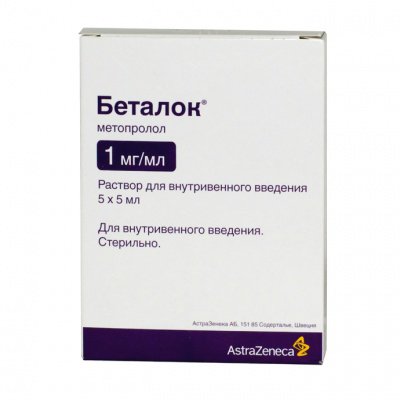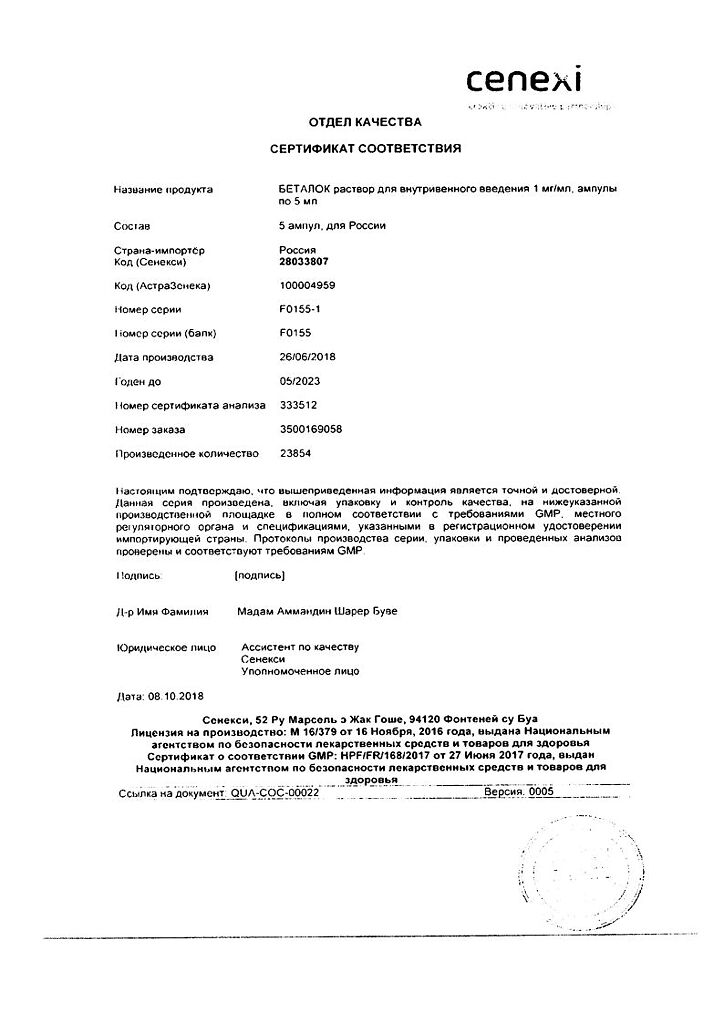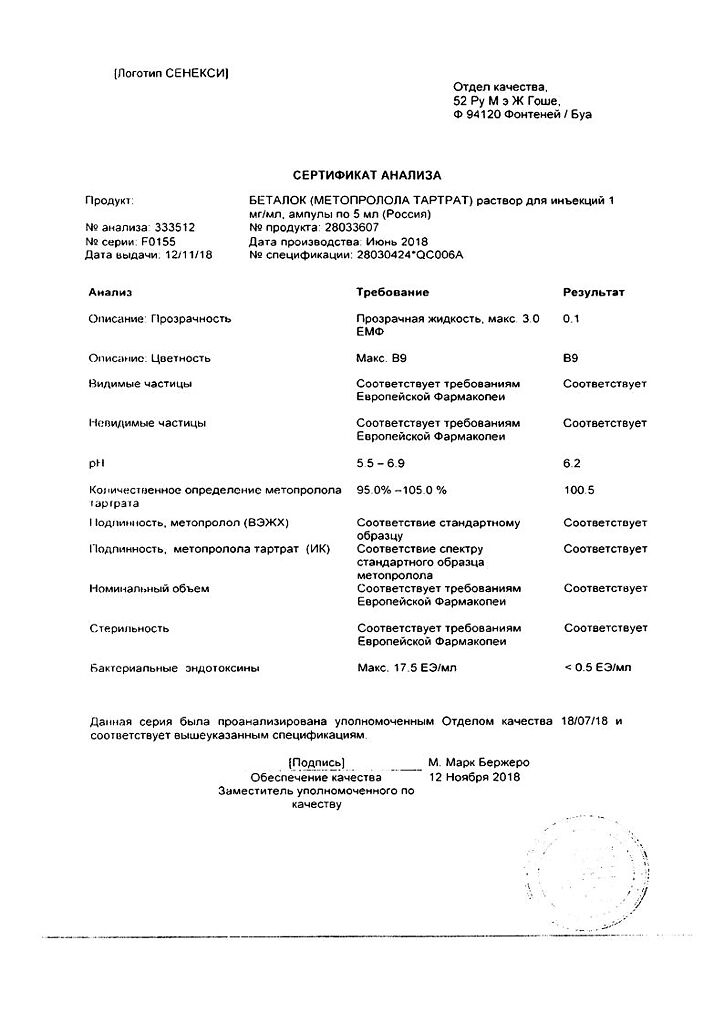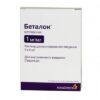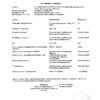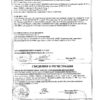No products in the cart.
Betaloc 1 mg/ml 5 ml , 5 pcs.
€1.00
Out of stock
(E-mail when Stock is available)
Description
In patients with myocardial infarction, intravenous metoprolol reduces chest pain and reduces the risk of atrial fibrillation and flutter. Intravenous metoprolol administration at the first symptoms (within 24 hours after the appearance of the first symptoms) reduces the risk of myocardial infarction. Early start of treatment with metoprololol leads to improvement of further prognosis of myocardial infarction treatment.
It achieves reduction of heart rate (HR) in paroxysmal tachycardia and atrial fibrillation (flutter).
Methoprolol is a β1-adrenoblocker that blocks β1-receptors at doses much lower than those required to block β2-receptors. Metoprolol has little membrane-stabilizing effect and no partial agonist activity. Metoprolol reduces or inhibits the agonist effect that catecholamines produced by nervous and physical stress have on cardiac activity.
This means that metoprololol has the ability to inhibit the increase in heart rate, minute volume, and myocardial contractility, as well as the rise in BP caused by the catecholamine release mode. In patients with symptoms of obstructive pulmonary disease, metoprolol may be administered in combination with β2-adrenomimetics if necessary. When used together with β2-adrenomimetics, Betaloc® in therapeutic doses has less effect on β2-adrenomimetics-induced bronchodilation than nonselective β-adrenoblockers.
Metoprolol has less effect than non-selective β-adrenoblockers on insulin production and carbohydrate metabolism. The effect of Betaloc® on the cardiovascular system response in hypoglycemia is significantly less pronounced compared to non-selective β-adrenoblockers. Improved quality of life with treatment with Betaloc® was observed in patients after myocardial infarction.
Indications
Indications
Active ingredient
Active ingredient
Composition
Composition
1 ml of the solution contains:
Active ingredients:
metoprolol tartrate for injection – 1 mg.
Excipients:
Sodium chloride for injection – 9 mg;
water for injection – up to 1 ml.
How to take, the dosage
How to take, the dosage
Injection of Betaloc at a rate of 1 to 2 mg/min should be started with 5 mg (5 ml) of Betaloc. The administration may be repeated at 5-minute intervals until therapeutic effect is achieved. Usually the total dose is 10-15 mg (10-15 ml). The recommended maximum dose when administered intravenously is 20 mg (20 ml).
Prevention and treatment of myocardial ischemia, tachycardia and pain in myocardial infarction or suspected myocardial infarction: intravenously 5 mg (5 ml) of the drug. It may be repeated at 2-minute intervals, the maximum dose being 15 mg (15 ml). Fifteen minutes after the last injection, give oral metoprolol at a dose of 50 mg (Betaloc) every 6 hours for 48 hours.
With impaired renal function: There is no need to adjust the dose in patients with impaired renal function.
Hepatic impairment: usually due to the low degree of binding to plasma proteins, no dose adjustment is required. However, in severe hepatic impairment (in patients with portocaval anastomosis) dose reduction may be required.
Elderly age: no dose adjustment is necessary in elderly patients.
Children: Experience with Betaloc in children is limited.
Interaction
Interaction
Co-prescription of Betaloc® with the following drugs should be avoided:
Barbituric acid derivatives: barbiturates (the study was conducted with phenobarbital) slightly enhance metabolism of metoprolol, due to enzyme induction.
Propafenone: When propafenone was administered to four patients treated with metoprolol, a 2-5-fold increase in plasma concentrations of metoprolol was noted, with two patients experiencing side effects characteristic of metoprolol. This interaction was confirmed during the study on 8 volunteers. The interaction is probably due to the inhibition of metoprolol metabolism by the cytochrome P4502D6 system with propafenone, similar to quinidia. Given that propafenone has the properties of a β-adrenoblocker, the combined administration of metoprolol and propafenone is not advisable.
Verapamil: A combination of β-adrenoblockers (atenololol, propranolol, and pindolol) and verapamil may cause bradycardia and lead to a decrease in BP. Verapamil and β-adrenoblockers have a complementary inhibitory effect on atrio-ventricular conduction and sinus node function.
Combination of Betaloc with the following drugs may require dosage adjustment:
Class I antiarrhythmic agents: Class I antiarrhythmic agents and β-adrenoblockers may result in a combination of negative inotropic effects, which may lead to serious hemodynamic side effects in patients with impaired left ventricular function. Such combination should also be avoided in patients with sinus node weakness syndrome and impaired atrioventricular conduction. Interactions are described using disopyramide as an example.
Amiodarone: Concomitant use of amiodarone and metoprolol may result in marked sinus bradycardia. Given the extremely long half-life of amiodarone (50 days), the possible interaction long after amiodarone withdrawal should be considered.
Non-steroidal anti-inflammatory drugs (NSAIDs): NSAIDs weaken the antihypertensive effect of β-adrenoblockers. This interaction is most documented for indomethacin. No described interaction has been noted for sulindac. No described reaction has been noted in studies with diclofenac.
Diphenhydramine: Diphenhydramine decreases the clearance of metoprolol to α-hydroxymetoprolol by 2.5 times. At the same time there is an increase in the action of metoprolol.
Epinephrine (adrenaline): Ten cases of severe arterial hypertension and bradycardia have been reported in patients taking non-separated β-adrenoblockers (including pindolol and propranepolol) and receiving epinephrine (adrenaline). Interactions were also observed in a group of healthy volunteers. It is assumed that similar reactions may also be observed when using epinephrine in conjunction with local anesthetics in case of accidental ingestion into the vascular bed. This risk is thought to be much lower with cardioselective β-adrenoblockers.
Phenylpropanolamine: Phenylpropanolamine (norephedrine) at a single dose of 50 mg may cause an increase in diastolic BP to abnormal values in healthy volunteers. Propranolol generally interferes with the BP elevation induced by phenylpropanolamine. However, β-adrenoblockers may cause nasoloxal arterial hypertension reactions in patients receiving high doses of phenylpropanolamine. Several cases of hypertensive crisis have been reported with phenylpropanolamine.
Hinidine: Quinidine inhibits metabolism of metoprolol in a special group of patients with rapid hydroxylation (approximately 90% of the population in Sweden), causing mainly a significant increase in plasma concentrations of metoprolol and an increase in β-blockade. A similar interaction is believed to be characteristic of other β-adrenoblockers whose metabolism involves cytochrome P4502D6.
Clonidine: Hypertensive reactions when clonidine is abruptly withdrawn may be increased when β-adreno-blockers are coadministered. When co-administered, if clonidine is withdrawn. discontinuation of β-adrenoblockers should be started several days before clonidine withdrawal.
Rifampicin: Rifampicin may increase metabolism of metoprolol, decreasing the plasma concentration of metoprolol.
Plasma concentrations of metoprololol may increase when combined with cimeguidine, hydratazip, selective serotonin inhibitors such as paroxetine, fluoxetine and sertratin. Patients taking metoprolol and other β-adrenoblockers (eye drops) or monoamine oxidase inhibitors (MAOIs) simultaneously should be closely monitored. Against the background of β-adrenoblockers, inhaled anesthetics increase the cardiodepressant effect. Patients receiving oral hypoglycemic agents may need to adjust the dose of the latter while taking β-adrenoblockers. Cardiac glycosides in co-administration with β-adrenoblockers may increase atrioventricular conduction time and cause bradycardia.
Special Instructions
Special Instructions
Patients taking β-adrenoblockers should not receive intravenous calcium channel blockers such as verapamil. Patients with bronchial asthma or obstructive pulmonary disease should be prescribed concomitant bronchodilator therapy. If necessary, the dose of β2-adrenomimetic should be increased. When using β1-adrenoblockers, the risk of their effect on carbohydrate metabolism or the possibility of masking hypoglycemia is significantly less than when using non-selective β-adrenoblockers.
In patients with decompensated chronic heart failure, a stage of compensation should be achieved both before and during treatment with the drug.
Patients with Prinzmetal angina should not be prescribed non-selective β-adrenoblockers.
Very rarely, patients with impaired atrioventricular conduction may worsen (possible outcome is atrioventricular block). If bradycardia develops during treatment, the dose of Betaloc should be reduced. Metoprolol may worsen the symptoms of peripheral arterial circulation disorder due to decreased blood pressure. Caution should be exercised when prescribing the drug in patients with severe renal insufficiency, metabolic acidosis, co-administration with cardiac glycosides.
In patients taking β-adrenoblockers anaphylactic shock is more severe. Patients with pheochromocytoma should be prescribed an alpha-alrenoblocker concomitantly with Betaloc. In case of surgery, the anesthesiologist should be informed that the patient is taking a β-adrenoblocker. A second or third dose should not be administered if heart rate is less than 40 beats per minute, PQ interval is greater than 0.26 seconds, and systolic blood pressure is less than 90 mmHg.
Contraindications
Contraindications
With caution: Grade I atrioventricular block, Prinzmetal angina, chronic obstructive pulmonary disease (pulmonary emphysema, chronic obstructive bronchitis, bronchial asthma), diabetes, severe renal failure.
Side effects
Side effects
Betaloc is well tolerated by patients and side effects are mostly mild and reversible.
The following undesirable side effects have been described in clinical trials or in the use of Betaloc (metoprolol tartrate) in clinical practice. In many cases, a causal relationship to treatment with Betaloc has not been established.
The following criteria were used to assess the incidence of cases:
Cardiovascular system: frequent – bradycardia, postural disturbances (very rarely accompanied by syncope), limb cooling, palpitations; infrequent – temporary increase in symptoms of heart failure, cardiogenic shock in patients with acute myocardial infarction; Grade I AV blockade; rare – other cardiac conduction disorders, arrhythmias; very rare – gangrene in patients with previous severe peripheral circulatory disturbances.
CNS: very common – fatigue; common – dizziness, headache; rare – increased nervous excitability, anxiety, impotence/sexual dysfunction; infrequent – paresthesias, seizures, depression, impaired attention, drowsiness or insomnia, nightmares; very rare – amnesia/memory disturbances, depression, hallucinations.
Gastrointestinal tract: frequently – nausea, abdominal pain, diarrhea, constipation; infrequently – vomiting; rarely – dry mouth.
Liver: rarely – liver function disorders.
The skin: infrequent – rash (as urticaria), increased sweating, rarely – hair loss, very rare – photosensitization, exacerbation of psoriasis.
Respiratory organs: often – shortness of breath with physical effort; infrequent – bronchospasm in patients with bronchial asthma; rarely – rhinitis.
Sensory organs: rare – visual disturbances, dry and/or irritated eyes, conjunctivitis; very rare – ringing in the ears, impaired sense of taste.
Metabolism: infrequent – increase in body weight.
Skeletal and muscular system: very rare – arthralgia.
Blood: very rarely – thrombocytopenia.
Overdose
Overdose
Toxicity: Metoprolol at a dose of 7.5 g in an adult caused intoxication with fatal outcome. A 5-year-old child who took 100 mg of metoprololol showed no signs of intoxication after gastric lavage. Administration of 450 mg metoprolol to a 12-year-old adolescent resulted in moderate intoxication. Administration of 1.4 g and 2.5 g metoprolol to adults resulted in moderate and severe intoxication, respectively. Administration of 7.5 g to adults resulted in extremely severe intoxication.
Symptoms: in metoprolol overdose, cardiovascular symptoms are most serious, but sometimes, especially in children and adolescents, CNS symptoms and suppression of pulmonary function may predominate. Bradycardia, grade I-lII atrioventricular block, asystole, marked BP decrease, poor peripheral perfusion, heart failure, cardiogenic shock, pulmonary function depression, apnea, increased fatigue, impaired consciousness, loss of consciousness, tremors, convulsions, increased sweating, paresthesias, bronchospasm, nausea, vomiting, possible esophagic spasm, hypoglycemia (especially in children) or hyperglycemia, hypercalcemia, renal effects, transient myasthenic syndrome. Concomitant ingestion of alcohol, antihypertensive drugs, quinidine, or barbiturates may worsen the patient’s condition. The first signs of overdose may be observed 20 minutes to 2 hours after taking the drug.
Treatment: administration of activated charcoal, if necessary, gastric lavage. IMPORTANT: Atropine (0.25-0.5 mg intravenously for adults, 10-20 µg/kg for children) should be given before gastric lavage (due to risk of vagus nerve stimulation). If necessary, maintenance of airway patency (intubation) and adequate ventilation. Replenishment of circulating blood volume and glucose infusion. ECG monitoring. Atropine 1.0-2.0 mg v/v, repeat administration if necessary (especially in case of vagus symptoms). In case of (suppression of) myocardial depression, infusion of dobutamine or dopamia is indicated Glucagon 50- 150 µg/kg v/v at 1-minute intervals may also be used. In some cases, the addition of adrenaline to therapy may be effective. In case of arrhythmia and increased ventricular complex (QRS), sodium solutions (chloride or bicarbonate) are infused. Installation of an artificial pacemaker is possible. In case of cardiac arrest due to overdose resuscitation measures for several hours may be required. Terbutaline may be used to relieve bronchospasm (by injection or inhalation). Symptomatic treatment is given.
Pregnancy use
Pregnancy use
Pregnancy: As with most drugs, Betaloc® should not be prescribed during pregnancy and while breastfeeding unless the expected benefit to the mother outweighs the potential risk to the fetus.
Like other antihypertensives, β-adrenoblockers may cause side effects such as bradycardia in the fetus, newborn or breastfed infants, so special care should be taken when prescribing β-adrenoblockers in the last trimester of pregnancy and immediately before delivery.
Lactation: The amount of metoprolol excreted into breast milk and the β-blocking effects in the breastfed baby (when the mother takes metoprolol at therapeutic doses) are small.
Similarities
Similarities
Additional information
| Shelf life | 5 years |
|---|---|
| Conditions of storage | In a light-protected place, at a temperature below 25 °C |
| Manufacturer | Seneci HSC, France |
| Medication form | solution for infusion |
| Brand | Seneci HSC |
Related products
Buy Betaloc 1 mg/ml 5 ml , 5 pcs. with delivery to USA, UK, Europe and over 120 other countries.

